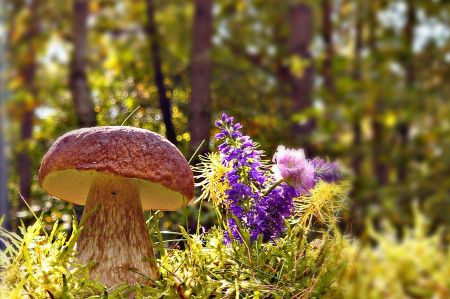Porcini mushrooms - a food specialty from the forest
- Written by Portal Editor
Our walks or rather hikes in the region around Lake Garder had already brought us a little closer to the giant parasol mushrooms, a type of mushroom that we had not previously had on our radar.
In contrast to the well-known porcini mushrooms (Boletus), which we hoped to find on another excursion in the adjacent forest. Of course, always with the aim of limiting the amount collected (if we find any at all). All species of the porcini mushroom genus are protected in Germany and may only be collected in small quantities for personal use.
Editorial comments on the subject of porcini mushrooms
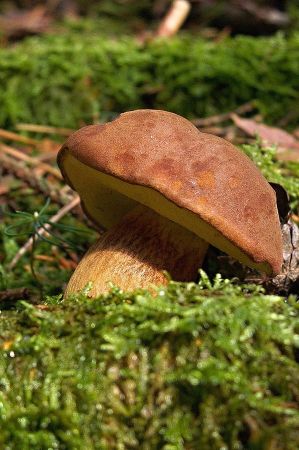 Porcini mushrooms, also known as the "king of mushrooms", have a distinctive, slightly nutty taste.
Porcini mushrooms, also known as the "king of mushrooms", have a distinctive, slightly nutty taste.
Drying the mushrooms makes the taste even more intense, so that the porcini mushrooms make every dish more full-bodied.
For vegetarians and vegans, they are the ideal meat substitute due to their high protein content and intense taste, and for meat lovers they are a great healthy addition or alternative.
But: Too much cadmium damages the liver and kidneys, too much mercury can affect the nervous system. The concentration in the mushroom body can be four to five times higher than in the forest floor. Adults are therefore advised not to eat more than 200 to 250 grams of wild mushrooms per week.
A hidden lake near the campsite
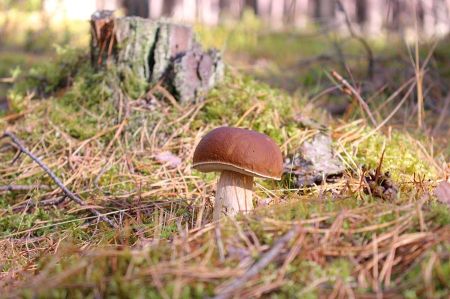 On one of our extensive hikes we came across a small lake near Lake Garder, which was to be the destination during our search for porcini mushrooms.
On one of our extensive hikes we came across a small lake near Lake Garder, which was to be the destination during our search for porcini mushrooms.
Porcini mushrooms can be found from July to November in coniferous or mixed forests, often on sandy soils. In autumn they are often difficult to find when the leaves are already falling from the trees and the mushroom bodies are hidden.
The young porcini mushrooms in particular are extremely hard, hence the name. So let's get started
Description of the porcini mushrooms - without going into too much detail
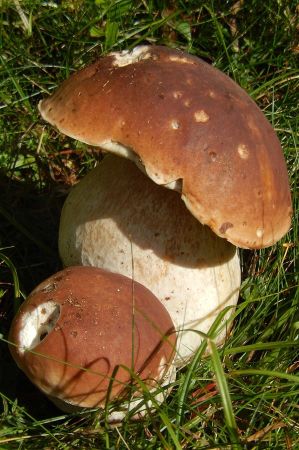 Although the porcini mushroom does not actually resemble any mushrooms that are poisonous, you should at least not confuse the porcini mushroom with one of its two counterparts: the common bitter bolete and the chestnut bolete. The former is inedible.
Although the porcini mushroom does not actually resemble any mushrooms that are poisonous, you should at least not confuse the porcini mushroom with one of its two counterparts: the common bitter bolete and the chestnut bolete. The former is inedible.
The porcini mushrooms form medium to large fruiting bodies that are characterized by thick, usually thickening stems at the bottom, with a reticulated or finely flaky, rarely bare surface and a tubular hymenophore (underside of the mushroom body). The cap is usually cushion-shaped, with a dry, finely felted or bare surface.
The cap color of the individual species ranges from whitish to gray and various shades of yellow, reddish brown and brown to black-brown, and the cap color can also vary within individual species. The tubular layer and the pores are white when young, and with age they first turn yellowish and then olive green due to the color of the spores.
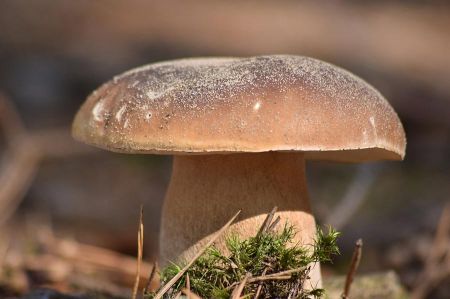 By the way: The porcini mushrooms form ectomycorrhiza (root symbioses) with various trees, with some very highly specialized ecotypes occurring. The mycelium forms a dense coat around the young, uncorked root ends. In response, the root ends swell and no longer develop root hairs.
By the way: The porcini mushrooms form ectomycorrhiza (root symbioses) with various trees, with some very highly specialized ecotypes occurring. The mycelium forms a dense coat around the young, uncorked root ends. In response, the root ends swell and no longer develop root hairs.
The fungal hyphae also grow into the root bark, but do not penetrate the root cells; instead, they form a network in the extracellular spaces that facilitates the exchange of nutrients between the fungus and the plant (Hartig's net). The hyphae of the fungus take over the task of the missing root hairs.
They reach far into the soil matrix, ensuring good and extensive nutrient and water absorption.
And we found what we were looking for - a small site by the lake
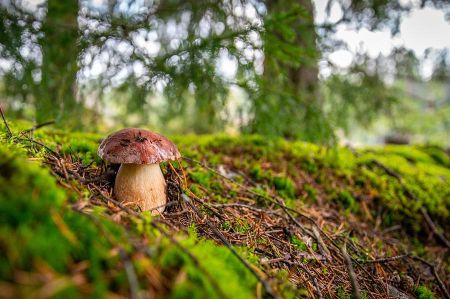 Hardly distinguishable from the surroundings, we came across a small site that already covered our needs. A paper carrier bag or a basket are good for transporting the porcini mushrooms, at least better than any plastic bag. As we learned from our parents, mushrooms are cut off just above the ground and only the earthy part is removed when cleaning.
Hardly distinguishable from the surroundings, we came across a small site that already covered our needs. A paper carrier bag or a basket are good for transporting the porcini mushrooms, at least better than any plastic bag. As we learned from our parents, mushrooms are cut off just above the ground and only the earthy part is removed when cleaning.
Wipe the caps with a soft cloth, scrape off any snails that have eaten them with a small knife. For larger specimens, remove the tubes from the cap with a knife, for smaller specimens, leave the sponge on.
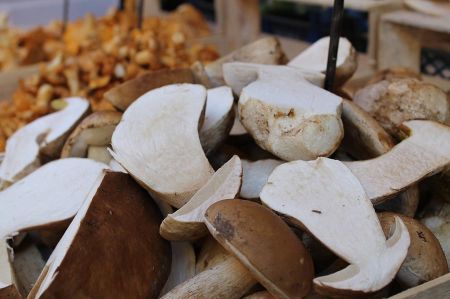 For cooking preparation, we recommend: cut the mushrooms into slices. Peel and finely dice the onions, chop the parsley. Heat a pan to high heat. Fry the porcini mushrooms in it without fat. Fry mushrooms dry: Please avoid frying the mushrooms in oil. After the mushroom liquid has come out, add the clarified butter and the onions. Cook for a further 2 minutes at a reduced heat. Sprinkle the chopped parsley into the pan and season the mushrooms with salt and pepper. Finally, stir in the butter.
For cooking preparation, we recommend: cut the mushrooms into slices. Peel and finely dice the onions, chop the parsley. Heat a pan to high heat. Fry the porcini mushrooms in it without fat. Fry mushrooms dry: Please avoid frying the mushrooms in oil. After the mushroom liquid has come out, add the clarified butter and the onions. Cook for a further 2 minutes at a reduced heat. Sprinkle the chopped parsley into the pan and season the mushrooms with salt and pepper. Finally, stir in the butter.
If you don't feel motivated to collect them yourself or are a little nervous, you can also buy porcini mushrooms. However, 1 kg of fresh porcini mushrooms can cost between €20 and €75. Depending on the weather conditions in the region of origin, there can be big price differences.
Please read as well:
